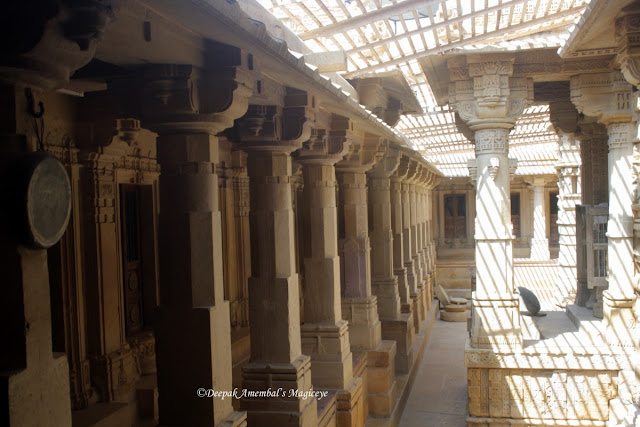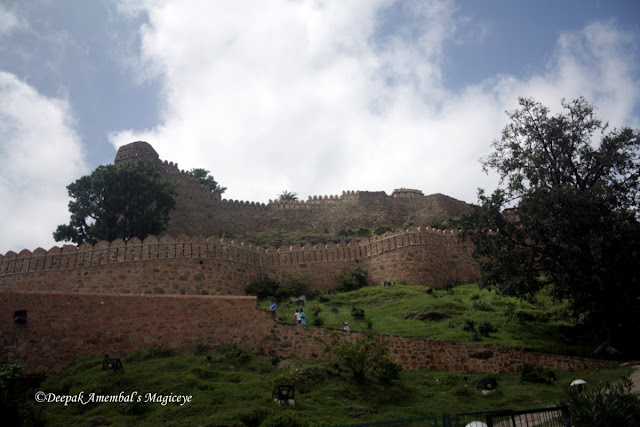Got on to the highway for Jaisalmer at 0830. The initial few
kilometers of road were bad on NH114 but later on NH56 it was good.
Reached Jaisalmer at 1300 and were guided through to the
Desert Boys Guesthouse in the Jaisalmer fort. This is a very traditionally
decorated Hotel.
We chose a room that suited us and after a briefing from the
informed owner about the history of Jaisalmer and what to see and do we had our
lunch and rested for awhile.
Jaisalmer is named after its founder Raja Jaisal a Rajput
king. "Jaisalmer" means "the Hill Fort of Jaisal".
Jaisalmer is sometimes called the "Golden City of India" because the
yellow sand gives a yellowish-golden tinge to the city and its surrounding area.
In the afternoon we visited the Jaisalmer Palace (adjacent to
our guesthouse) which is rather shabby. Not many artefacts in the museum. Only
good for panoramic views of the city. After a brief tour we went to the Nathmal
ki Haveli and the Patwa Haveli, which were situated just outside the fort. The
Nathmal Haveli could be viewed from outside and the lobby while the Patwa
haveli was a muesum. It was an amazing experience.
Patwon-ki-Haveli: Guman Chand Patwa (and later by his five
sons), a wealthy merchant belonging to powerful Oswal Jain community and banker
who had over three hundred trading centres from Afghanistan to China. This
ornate five-storey complex took fifty years to complete. This is the largest,
the most magnificent, and the most elaborate of Jaisalmer havelis.
Nathmalji-ki-Haveli: Built by a Prime Minister of princely
state of Jaisalmer. Its facade is a riot of ornamentation: flowers, birds,
elephants, soldiers, a bicycle and even a steam engine.
We got to view a wonderful sunset from the guesthouse sit
out.
On our way through the fort we noticed plenty of Italian
restaurants! Hence we decided to dine at one that was very close to our
guesthouse. There was a huge board announcing its existence but the entrance
was through a narrow passageway and had to climb up some steep stairs to reach
the roof top. The tourists have not started pouring in as yet and here again we
were the only customers! We ordered for Canneloni and Lasagna, both vegetarian
as there was only an egg dish which could qualify as non vegitarian.
Vegetarians will not have a problem in Rajasthan, as most of the Rajasthan
cusine is vegetarian. The food took an hour to make it to the table but was
value for money.
The agenda for the next day was a visit to the Jain temple
in the morning followed by the Jeep safari to Sam sand dunes for a total
Rajasthani experience.
Like all Jain temples this too was beautifully carved.
This Shitalnathji jain temple was built in 1486.
After the temple visit we moved on to street shopping of
puppets and miniature art.
Before you go shopping it is advisable to ask the
Hotel reception what the reasonable price would be for things that you want to
buy. Bargaining is a must.
Had lunch at ‘8july’ cafe in the marketplace. It is a
multicuisine restaurant and like all restaurants in Rajasthan caters to the
European tastes.
However the personal attention of the owner ensures that you
will get the food with an Indian touch if you so desire.
The jeep safari to the sand dunes is a fun trip.
On the way we stopped at Bada Bag six kms north
of Jaisalmer. There are Royal cenotaphs with carved
images of late Maharawals
and their families where each chhatri preserves an inscribed tablet recording
the death of Maharawals on which the memorials are raised. The chhatris have
been built in a set pattern but in different sizes.
The next stop was Luderwa16 kms. northwest of Jaisalme.
Luderwa is the old capital of Jaisalmer. Now a
silent city, the only witness to
its former splendour are the Jain temple, toran (ornate arch) and artificial
divine
tree (Kalptaru).
Finally we were
taken by jeep to a point in the Thar desert where there were camels waiting to
take us to
the sunset point. Once the sun bid goodbye, we were taken to a camp
where there was a cultural
programme of Rajasthan music and dance followed by a
buffet of Rajasthani food.
Had a great time and headed back to the hotel.
Next stop would be Bikaner!

























































